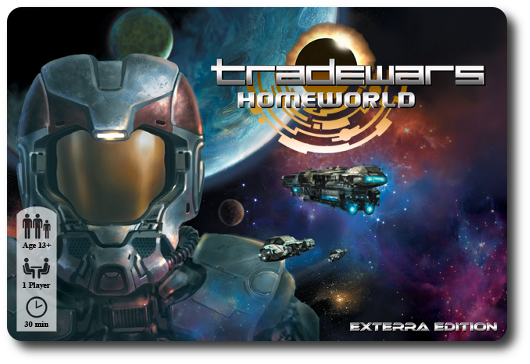
The Basics:
- For ages 8 and up (publisher suggests 13+)
- For 1 or more players
- Approximately 30 minutes to complete
Geek Skills:
- Active Listening & Communication
- Counting & Math
- Logical & Critical Decision Making
- Reading
- Strategy & Tactics
- Risk vs. Reward
- Hand/Resource Management
Learning Curve:
- Child – Moderate
- Adult – Easy
Theme & Narrative:
- Space is full of greedy people
Endorsements:
- Gamer Geek approved!
- Parent Geek approved!
- Child Geek approved!
Overview
We have mapped the universe and know two things. First, it’s vast. Second, it’s mostly empty, but not devoid of life. Resources can only be found on certain planets and a race’s homeworld is more akin to a lifeboat than a throne. Survival is dependent on how hard you make it for others to kill you.
Tradewars: Homeworld is comprised of 60 Upgrade cards (covering Starships, Crew, Weapons, and Tactics), 3 Scenario cards, 3 Derelict cards, 1 Derelict Reference card, 1 Role Reference card, 1 Deck Screen car, 1 black standard ten-sided die, 2 black standard six-sided dice, 1 blue standard six-sided die, 1 red standard six-sided die, 5 cubes (in the colors yellow, orange, red, blue, and green), and 1 Progress mat. The cards and mat are as thick and as durable as your standard playing card. The artwork is excellent, portraying the different locations and high-tech ships that fly in the far reaches of space.
Blasting Off
Note: In order to play the game, each player needs their own set. A single set cannot be played by anymore than 1 player. We have summarized a 2-player game here.
To set up, first have each player separate their Upgrade cards from the rest of the deck and then organize their Upgrade cards into 4 different piles. Each pile will either represent Crew, Weapons, Tactics, or Starships. Do not mix cards from different game sets.
Second, each player shuffles their Upgrade piles individually and places them in a row in front of them.
Third, each player draw 4 Level 1 Upgrade cards and 4 Level 2 Upgrade cards to create their starting deck. Each player then shuffles their deck, places it face-down, and covers it with their Deck Screen card. This is the player’s draw deck for the duration of the game.
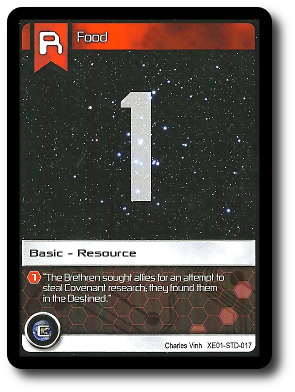
Fourth, each player places their Progress mat to one side of their playing area and uses the yellow, orange, and red cubes to mark the zero position on the Treasury track and the blue cube to mark the 18 position for starting Life Points. The Green cube stays in the zero position, as well.
That’s it for game set up. Determine who will go first and begin.
Choose Your Adventure
Tradewars: Homeworld uses scenarios to determine how the game is won. Three scenarios are provided. Each are summarized here.
- Tradewars: Players must balance the collection of wealth with their need to defend their homeworld.
- Spacewars: This scenario is all about survival. Be the last player standing to win.
- The Derelict: A single-player scenario that focuses on surviving an assault.
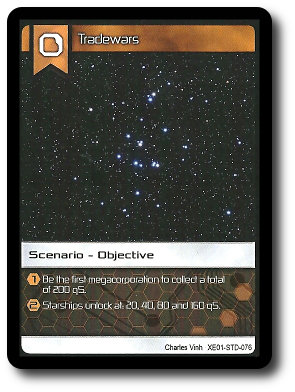
Select the scenario and place the cards to one side. The rest go back in the game box.
Not So Empty Space
Tradewars: Homeworld is played in turns. A player’s turn is summarized here.
Step 1: Select Role
The first thing a player does on their turn is select a role they will use. Each of the 10 roles are summarized here.
- Chancellor: Can initiate a diplomatic vote to reach an agreement in the game
- Treasurer: Discard cards for funds
- Admiral: Control multiple starships
- Captain: Reconfigure starships
- Engineer: Reconfigure weapons
- Sergeant: Force all opponents to discard
- Private: Force 1 opponent to discard
- Smuggler: Force 1 opponent to discard and then the player collects funds
- Trader: Draw cards
The scenario will determine which of the 10 roles are more desirable during the game, but each role has its purpose. The challenge for the player is to determine what actions and benefits they need in hopes of moving their agenda forward. Caution should be taken when selecting the role, as it locks the player into certain types of decision making for their entire turn.
Once the player has determined their role, they announce it and continue.
Step 2: Resolve Role
Depending on what role was selected, the player now takes whatever action the role provides. This not only includes an action specific to the role, but bonus card draws and the collecting of funds. Players can also use “Tactic” Upgrade cards during their turn to further their goals.

Step 3: Trade and Discard Cards
If the player likes, they can now trade cards to buy Upgrade cards and discard cards.
Trading is a form of commerce. Cards from the player’s hand are “traded” in for their Trade Value. Trade Values range from “1” to “5”. The number of points in the value can then be spent to acquire new Upgrade cards. These are used to build and refine the player’s deck.
Step 4: Adjust Progress Mat
As the game continues, the player will have need to adjust the cube location on the Progress mat. Adjustments are made whenever necessary and in accordance to card effects or player actions. Wealth, Life Points, and the number of starships the player can build are kept track on the mat.
Starships and Space Lanes
As the game continues, the players will eventually get their hands on some high-tech starships. These can be deployed to the Space Lane, a special play area in front of the players. Starships act as walls, protecting the player’s homeworld from invasion. Of course, if a player is attacking a foe who does not have any starships in the Space Lane, the opponent’s homeworld is easily dispatched.
Before a starship can be sent into space, it must be configured. Configuring a starship entails attaching 3 Upgrade cards together. These are the “Starship” Upgrade card, the “Crew” Upgrade card, and the “Weapon” Upgrade card. Now the starship is maned, armed, and ready to fly.
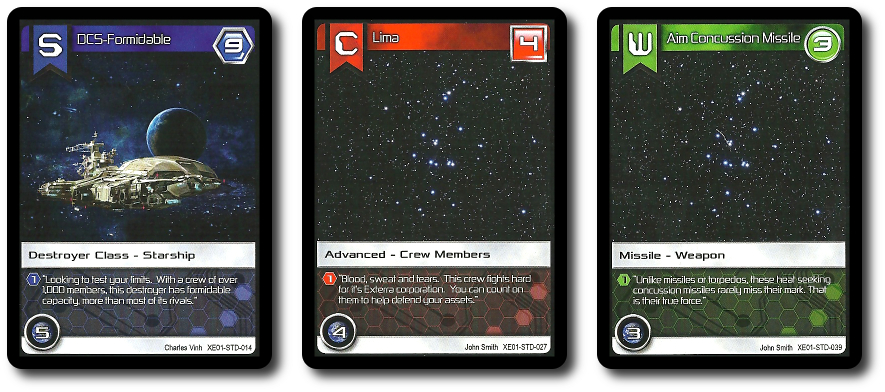
Using the three Upgrade cards, the player now has a starship with an Energy Rating (or “capacity”), Crew Rating (or “resistance”), and Weapon Rating (or “firepower”).
Banking and Protecting Your Homeworld
“Banking” is the term used when cards are sold to increase the player’s Treasury value. The common currency of the galaxy is used to buy upgrades and such. QuickSilver (QS) is a unique measurement of wealth. QS is a rare metal that can easily be shaped to represent any other currency, but at much lower cost.
All of which is beneficial for the player’s homeworld. As the player’s base of operations, it contains all their wealth and tactical equipment. From here, the player commands their forces, but if it should fall, they have lost. Starships will help protect the player’s homeworld, but such resources must also be spent to attack foes. As such, a player will need to balance defense capabilities and offense capabilities to survive.
Combat In Space
Combat is initiated when the player decides to use their starships to attack an opponent’s starships or an opponent’s unprotected homeworld. Attacking is only possible if the player elects to take the Admiral role for their turn.
Attacks can be done with 1 or more starships and the attacker gets to decide which of the opponent’s ships are included in the skirmish.
Initiative is determined by rolling dice. If the attacking player wins the initiative, the battle continues. If not, the opponent is able to escape the fight
If combat does commence, the attacker determines their total firepower and determines if it’s higher or equal to the defender’s resistance. If so, the enemy ship is destroyed. Counter-attacks are possible, meaning the exchange of laser fire could be coming from both directions. This means starting an attack could end up being a terrible idea, as the would-be target turns their starships and shoots the attacker out of the sky.
Ending the Turn
When the player is done taking all their actions, they draw back up to 5 cards, but only if they have 4 or fewer cards. If their draw deck is exhausted, the discard pile is shuffled and becomes the new draw deck.
Winning the Game
The players continue to take turns until the game is won. The victory condition is determined by the scenario selected by the players. Once the objective has been met, the game is over and the winner is announced.
To learn more about Tradewars: Homeworld, visit the game’s web page.
Final Word
Oddly enough, the Child Geeks very much liked the fact that both players had the same cards. According to one Child Geek, “If everyone starts with the same cards, then you know the game is fair.” Some of the Child Geeks had difficulty balancing their resources and a few more focused too much on building starships or on specific tasks. It was also apparent that some of the roles in the game were favorites, as several players repeated their use again and again, even when it wasn’t optimal to do so. As one Child Geek put it, “This game lets you do whatever you want and right now I want to blow up my opponent’s homeworld.” So be it. When the games were over, planets nuked, and resources spent, the Child Geeks voted to approve the game.
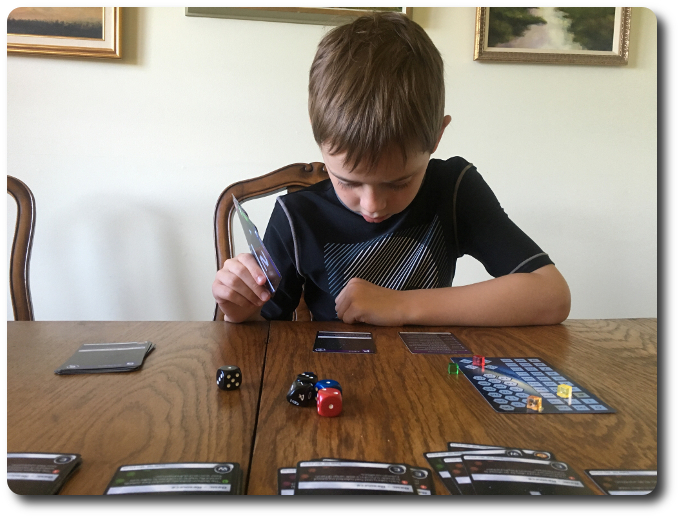
My son carefully considers his next role in the game…
The Parent Geeks are always up for a deck-building game and started enjoying Tradewars: Homeworld almost immediately. As one Parent Geek put it, “The game is easy to learn, but I really like how much thought you can put into it. If I wanted to, I could spend a lot more time thinking about my turn than what many would like.” The game does seem a bit bottomless at times when it comes to its depth of play. This is mostly due to the many combinations with cards in hand and roles to select. Another Parent Geek said, “It’s not about fighting and it’s not about power. This is a game about being aware and thinking things through, about being flexible and knowing where opportunities can be found.” Which sounds pretty dramatic, but in this case, the Parent Geek is right. This is a game that can take 100% of your brain. After all the games were over, the Parent Geeks voted to approve Tradewars: Homeworld.
The Gamer Geeks quickly caught on to the subtle game play that was not immediately visible. Caught on and loved it. According to one Gamer Geek, “I don’t say this often, but I think this game is genius. The designer has done a great job of staging the game play and options so as to allow players to do a great deal.” Many Gamer Geeks said the game was self-empowering, meaning it let the Gamer Geeks play the game they wanted to. The deck-building aspect was not seen as anything special, but the use of that mechanic with the rest of the game made everything smooth. As one Gamer Geek put it, “To create a game like this, you have to depend on the players to not give up or want their hand held. I like games that challenge you and won’t give up its secrets just because you think it’s difficult.” When the galaxy was won, the Gamer Geeks declare Tradewars: Homeworld a game they would gladly play again.
At first blush, Tradewars: Homeworld appears to be yet another deck-building game. Which isn’t bad, if you enjoy deck-building games, but being just one more head in the crowd does little to draw interest. All it takes is one game and you quickly realize that Tradewars: Homeworld is anything but “your typical game”. There’s a lot going on right from the start that is cleverly backed into the game’s standard game play. For example, the selection of roles is going to cause serious game players a lot of stress. It’s not simply enough to collect the right cards, but players must match the best role to their current hand to attain their goals. There’s more than just a little finesse going on here, as a clever player can completely reduce the luck factor to zero. You just have to think it through.
The building of ships is also clever, allowing players to customize and take the battle to their opponents in a way that is very empowering. It’s not just about the ship. The player must pick the crew and the weapons they us. A player will feel invested, since each ship is a serious hit to their deck of cards. And yet, if the player is not able to build the ship they want, simply having enough ship cards keeps the player in the game, populating the Space Lane with spaceships that might not be optimal, but most certainly do the trick.
Finally, tactics brings it all together. When you add in the roles, the cards in the player’s hand, the cards to be collected, the use of resources, and then the tactics, you have essentially created the perfect weapon. More than once in the game, I felt that the true goal was to complete the “perfect turn”, where everything worked on multiple levels and provided a very positive return on my mental investment. Totally possible, but damn hard to get.
I am very pleased with Tradewars: Homeworld. At the game’s core are simple rules that make it easy to teach and easy to get to the table. A few turns in and the players will learn as they go, having enough chances to experiment and determine how best to proceed. This game has a tremendous amount of patience, but time is short. Depending on the scenario, the road to victory could be a fast Space Lane or a slow voyage through the cosmos. Either way, players will be swept up by it and enjoy the ride. Do play Tradewars: Homeworld when time allows.
This game was given to Father Geek as a review copy. Father Geek was not paid, bribed, wined, dined, or threatened in vain hopes of influencing this review. Such is the statuesque and legendary integrity of Father Geek.




Thanks for the review. Sounds interesting. Any clues about how to learn more or get a copy?
There’s no entry at boardgamegeek.com and really not much of any information available on the web.
Greetings, Patrick, and thanks for taking the time to leave a comment.
I suggest you following the game’s Facebook page. The missing logistical and financial components you require should be provided soon.